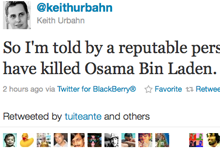Word of Osama bin Laden’s death spread on Twitter about 45 minutes before President Barack Obama announced that the U.S. had killed the terrorist leader.
According to The New York Times’ Brian Stelter, White House Communications Director Dan Pfeiffer tweeted just after 9:45 p.m. Sunday, “POTUS to address the nation tonight at 10:30 PM Eastern Time.”
The first credible information that Obama would announce bin Laden’s death came at 10:25 p.m. from Keith Urbahn, chief of staff for former Defense Secretary Donald Rumfeld. Urbahn tweeted, “So I’m told by a reputable person they have killed Osama Bin Laden. Hot damn.”
Within minutes, CBS News Capitol Hill producer Jill Jackson tweeted confirmation:
The Atlantic summarized what happened next:
“With cable news anchors afraid to confirm the news of bin Laden’s death before they had multiple sources of their own — Twitter quickly backed up with more confirmations, from senior administration officials and others — newspapers quickly jumped ahead of the story. As print reporters shared notes and confidential sources over Twitter, Wolf Blitzer stood in front of a green screen on CNN (he was at home when he got the news of Obama’s press conference) and teased the audience: ‘We have strong suspicions of what this news might be,’ he told viewers.
“It wasn’t until about 10 minutes to 11 p.m. that Blitzer finally cut away to John King, CNN’s chief national correspondent, and cable news viewers learned that bin Laden had been killed earlier in the evening. Just minutes before … MSNBC spread the word.”
Matt Rosoff declared in a Business Insider post that “Twitter just had its CNN moment.”
A few hours after Obama’s speech, Twitter users discovered that Sohaib Athar, an IT consultant in Abbottabad, had tweeted about a helicopter hovering overhead in the middle of the night, followed by a blast. He apparently was live-tweeting the raid on bin Laden’s compound.
Some of the stories ahead:
- If photos of bin Laden’s body surface, how should journalists handle them? When Saddam Hussein was hanged and when his sons were killed, those images were published and aired as a way of convincing doubters that they were really dead.
- What will bin Laden’s death mean for Americans’ willingness to continue the war in Afghanistan? How about the war on terror?
- How will people around the world perceive images of Americans celebrating in front of the White House? Could they inflame bin Laden sympathizers? PBS NewsHour noted this concern in its post on bin Laden’s death.
- How will the U. S. treat bin Laden’s body? Wire services reported early Monday morning that his body is being treated according to Islamic traditions. This could be a significant issue. Islamic tradition does not allow for cremation, only burial. The U.S. government probably doesn’t want to create a burial site that could become a rallying point for terrorists. ABC News reported early Monday that the U.S. plans to bury bin Laden at sea, attributing the information to an unnamed source.
Mashable is running a poll asking readers how they learned of the death. By 1:45 a.m., about 40 percent of those responding said Twitter was their first source of information.
Breaking news alerts signaled readers to check news websites for updates. These screenshots capture how websites handled news of bin Laden’s death.
For those waking up to the news, today’s front pages will be iconic, as were the front pages from September 11, 2001 and on the first anniversary of the attacks.










Comments